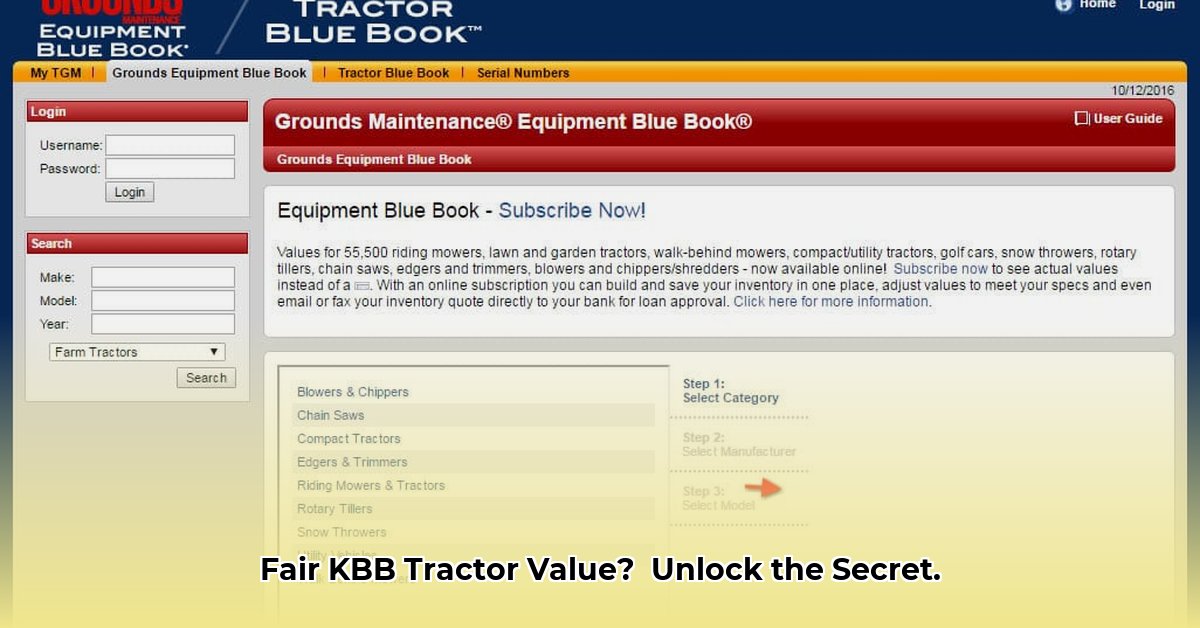
Understanding Used Tractor Pricing: A Comprehensive Guide
Buying or selling a used tractor? Determining its fair market value can seem daunting, but with the right approach, it's achievable. This guide provides a step-by-step process to help you confidently price your tractor, ensuring a fair transaction for both buyer and seller. We'll explore online resources, dealer insights, and essential factors influencing tractor value. Remember, accurate valuation is key to successful sales and purchases in the competitive agricultural equipment market. For additional valuation resources, check out this helpful tractor value guide.
Multiple Avenues to Determine Fair Market Value
Relying on a single source for used tractor valuation is risky. A comprehensive approach, combining several methods, is essential for accuracy. Let's examine the most effective strategies:
1. Online Market Research: Your Digital Detective Work
Begin your search by exploring online marketplaces like TractorHouse, Fastline, and eBay. These platforms offer a wealth of listings, providing a broad overview of prices for similar tractors. However, remember these are estimates. Focus on these key aspects for each listing:
- Model and Year: Identify tractors matching your model and year of manufacture. Similar models from different years generally have different values.
- Hours of Operation: Lower operating hours typically indicate better condition and higher value.
- Condition: Assess the stated condition – excellent, good, fair, or poor – as this significantly impacts price.
- Included Attachments: Additional implements (plows, loaders, etc.) increase the overall value.
- Location: Consider the geographic location of listed tractors, as prices can vary regionally due to supply and demand.
Why don't online prices always agree? Variations stem from differences in seller descriptions, condition assessments, and fluctuating market demand. Consequently, using multiple sources is crucial for a well-rounded perspective.
Don't let online estimates be your sole determinant. The next step is equally critical.
2. Dealer Expertise: Getting the Insider Perspective
Local tractor dealers possess invaluable market knowledge. They see firsthand what's selling and for what prices in your region. This provides context that online tools often miss.
- Contact multiple dealers: Reach out to several dealers in your area familiar with the market.
- Present your online research: Sharing your online findings enhances the discussion and allows dealers to refine their estimates based on your tractor's specifics.
- Consider trade-in options: Dealers might offer trade-in values, providing a further benchmark for your valuation.
3. Thorough Inspection and Documentation: The Foundation of Accurate Pricing
A meticulous inspection is paramount. Before even considering pricing, conduct a thorough assessment of your tractor's condition, documenting everything.
- Detailed Photography: Create a comprehensive visual record. Capture images of all sides, highlighting any scratches, dents, rust, or wear.
- Mechanical Assessment: Carefully note any mechanical issues, needed repairs, or maintenance records. This transparency is essential for accurate valuation.
- Documentation: Maintain meticulous records of repairs, upgrades, and maintenance. The more transparent you are about the tractor's history, the better the negotiation process will ultimately be.
4. Rarity and Unique Features: Adding Value to Your Assessment
Certain factors can elevate a tractor's value beyond the standard metrics.
- Rare Models: Less-common models or those with unique features command higher prices due to lower supply.
- Custom Modifications: Aftermarket modifications or special attachments can significantly influence the overall worth.
Comparing Valuation Methods: Pros and Cons
Here's a summary comparing the advantages and disadvantages of each approach:
| Method | Advantages | Disadvantages |
|---|---|---|
| Online Marketplaces | Wide range of listings, ease of access, initial price benchmark | Inaccurate estimates, incomplete details, lack of personalized service |
| Dealer Estimates | Localized market expertise, personalized assessment, trade-in options | Potential bias, time required for estimates |
| Professional Appraisal | Objective evaluation, detailed report, beneficial for legal transactions | Highest cost |
Navigating Market Dynamics: Supply, Demand, and Economic Factors
Remember, the agricultural equipment market isn't static. Numerous factors influence pricing beyond the tractor itself.
- Supply and Demand: High demand and low supply boost prices, and vice-versa.
- Seasonal Fluctuations: Demand varies seasonally, affecting pricing during peak agricultural periods.
- Economic Conditions: General economic trends and agricultural market conditions also play a role.
Key Takeaways: Your Path to Fair Tractor Valuation
- Multiple Data Points: Never rely on a single source for valuation. Combine online research, dealer insights, and your assessment of your tractor's condition.
- Transparency: Be upfront about your tractor's condition and history. This will improve accuracy in market value determination.
- Ongoing Market Awareness: Stay updated on current market trends to anticipate potential price fluctuations.
By carefully following these steps and considering the market dynamics, you're considerably increasing your ability to achieve a fair and realistic valuation for your tractor. Applying this comprehensive approach minimizes risk and ensures a smooth transaction.